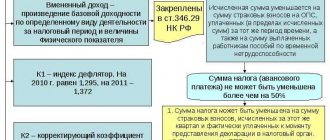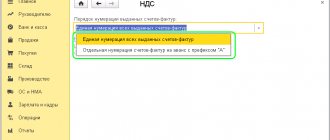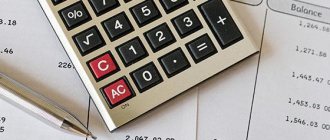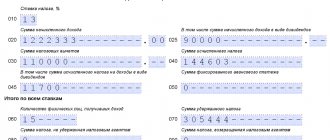Is there a “safe” VAT deduction amount?
How to assess whether an organization pays enough value added tax? After all, absolute numbers in this regard are completely uninformative. The amount of tax depends on a combination of factors, including the type of activity, profitability, markup, seasonality and many others, including the general economic situation in the country. Therefore, the wording of the question “ how much VAT should I pay so that the tax authorities do not want to come with an audit?” "is itself incorrect.
It is much more correct to ask the question about the share of deductions in the total amount of accrued VAT, because it is this indicator that tax authorities pay attention to. Officially, it is called the share of VAT deductions in the calculated amount of VAT on taxable items.
For the Russian Federation, the threshold value of this indicator as of November 1, 2019 is
87,39%
The size of this indicator for Russia previously, as of August 1, 2019, was 86.93%
For information on the safe share of deductions by region, see below - these are the figures that the local tax office focuses on when checking.
For Moscow, the threshold value of the indicator as of November 1, 2019 is
88,76%
The size of this indicator for Moscow earlier, on August 1, 2019, was 88.08%
What to do if the safe threshold is exceeded
Exceeding the established standards is not a cause for concern. The company needs to prepare in advance to communicate with controllers. It is important to document the validity and legality of applying the value added tax benefit.
There are no restrictions on the amount of deductions. The company has the right to declare 100% of the calculated tax, and even more. The situation is possible in the following cases:
- The company made a bulk purchase, the implementation of which will occur only in the next reporting period.
- Expensive equipment was purchased.
- The customer refused a major transaction for which materials or components had already been purchased.
- Other circumstances.
What to do if the Federal Tax Service requires clarification:
- Describe in detail the situation due to which the company claimed a large amount of deductions.
- Attach copies of the agreement, invoices, payment orders and other documents confirming the circumstances.
Probably, the head of the company will be invited for a personal conversation with the Federal Tax Service. There is no need to be afraid. A personal meeting is one of the ways to identify fly-by-night companies. If the company operates in good faith, then there is no need to worry.
Calculation of the share of VAT deductions
What does this indicator mean and how is it calculated? This is nothing more than a percentage of VAT deductions in the amount of accrued tax. To calculate it, you need only two values, which can be found in section 3 of the VAT return. This is line 190 (VAT deductible) and line 118 (VAT accrued).
The indicator is calculated using the following formula:
VAT deductible / VAT accrued * 100%
In order to see the dynamics of this indicator, it is better to take the relevant data from the last four declarations.
The result of the calculation will be a percentage value corresponding to the share of VAT deductions in the total amount of accrued tax. In other words, this value shows what percentage of the accrued VAT the company claims to deduct. It is this that the tax authorities will compare with the threshold indicator in order to draw a conclusion about the degree of tax risks of the company for VAT. If the proportion of VAT deductions according to the taxpayer’s declaration is greater, then this immediately attracts the attention of tax inspectors.
An example of calculating the safe amount of VAT deduction
Let’s assume that during the reporting period, a taxpayer from Moscow paid VAT in the amount of 100,000 rubles.
It is impossible to say whether this is a lot or a little for this organization. But the picture becomes clearer if we calculate the share of VAT deductions:
According to the company’s declaration, for the specified period the amount of calculated VAT, taking into account the restored amounts, is 1,500,000 rubles (
). The tax deduction for the same period amounted to 1,400,000 rubles (
). Substituting these figures into the above formula, we find that the share of VAT deductions in the amount of accrued tax in the period under review was 1,400,000 / 1,500,000 = 93.33% . This is more than the threshold value of 88.76% for Moscow (as of November 1, 2019), which means that the tax authorities have a reason to take the taxpayer into custody.
What should be the amount of VAT in the considered example for Moscow, so as not to attract increased attention from tax authorities?
It can be calculated using the reverse formula: accrued VAT * (100 – safe VAT) / 100 = = 1,500,000 * (100 - 88.76) / 100 = 168,600 rubles.
Based on the criteria used by the Federal Tax Service, the company in our example needs to pay at least 168,600 rubles in VAT in order not to leave the “safe” zone.
Control over VAT benefits
Tax deductions reduce the amount of taxes payable to the budget. Control over the replenishment of the state treasury is entrusted to the Federal Tax Service. The inspectorate annually draws up a plan for tax audits, in accordance with the order of the Federal Tax Service dated May 30, 2007 No. MM-3-06 / [email protected] Appendix No. 2 to the order lists special criteria for self-assessment of taxpayers’ risks.
Among the special criteria is a formula for calculating the safe share of VAT deductions. If the taxpayer’s benefits exceed the calculated values, the Federal Tax Service will include the company in the on-site inspection plan. In case of a single excess, the inspection will request an explanation. But if large VAT returns turn into a system, then an audit cannot be avoided.
IMPORTANT!
The controllers believe that the basis for including a company in the on-site inspection plan is the systematic excess of the share of benefits over a long period of time. If within 12 calendar months the amount of declared privileges exceeded 89% of the tax, then the organization will be included in the list of “lucky ones”.
What are the consequences of exceeding the threshold value?
Obviously, verification will not knock on your door as soon as the specified indicator leaves the “safe” zone. After all, as mentioned above, there are four dozen criteria for assessing tax risks. This is exactly why the fact that the share of VAT deductions is in the “safe” zone in no way guarantees the lack of interest of the Federal Tax Service in the taxpayer.
Thus, if the share of VAT deductions has gone beyond the threshold value, we can assume that the scales have tilted slightly towards an on-site tax audit of your company. However, you should not be afraid of this, because if the business is conducted honestly, then the entrepreneur, director or accountant always has something to object to the claims of the Federal Tax Service employees.
Standard indicators
Neither the current edition of the Tax Code of the Russian Federation, nor the unified information portal nalog.ru contains such a definition as the safe share of VAT deductions. At the same time, tax authorities continue to use regulatory values to create inspection and audit plans.
The calculation includes not only the federal indicator of 89% (established in order MM-3-06/ [email protected] ). Regional values, which are calculated based on statistical information, are also analyzed.
The Inspectorate does not publish regional values of the safe VAT share. The controllers provided only a general procedure for calculating the share of VAT deductions for a constituent entity of Russia. Calculate the percentage based on open data from the 1-VAT statistical report.
It is enough to select the reporting period for which you want to calculate the percentage. By clicking on the link (reporting year), select a report compiled by constituent entities of the Russian Federation. Download reports for calculations and analysis.
Safe VAT deduction by region
Information on the safe share of VAT deduction for the fourth quarter of 2019 can be calculated according to the tax report 1-VAT.
We have already calculated all the data and compiled it into one table :
| Safe share of deductions as of 11/01/2019 | Safe share of deductions as of 08/01/2019 | Safe share of deductions as of 05/01/2019 | Safe share of deductions as of 02/01/2019 | |
| RUSSIAN FEDERATION | 87,39% | 86,93% | 86,10% | 88,05% |
| including: | ||||
| Central Federal District | 89,26% | 88,76% | 88,48% | 89,51% |
| Belgorod region | 91,63% | 91,68% | 92,00% | 92,75% |
| Bryansk region | 90,11% | 88,89% | 86,69% | 92,97% |
| Vladimir region | 85,34% | 85,73% | 85,73% | 87,45% |
| Voronezh region | 92,93% | 92,91% | 93,53% | 92,41% |
| Ivanovo region | 92,56% | 92,23% | 92,36% | 94,08% |
| Kaluga region | 90,01% | 89,90% | 90,03% | 89,23% |
| Kostroma region | 86,08% | 85,73% | 87,83% | 89,76% |
| Kursk region | 89,94% | 91,35% | 91,74% | 91,91% |
| Lipetsk region | 104,42% | 105,42% | 106,71% | 109,05% |
| Moscow region | 89,04% | 88,74% | 88,99% | 89,85% |
| Oryol Region | 92,97% | 92,55% | 93,47% | 94,65% |
| Ryazan Oblast | 83,23% | 83,81% | 85,76% | 85,14% |
| Smolensk region | 95,32% | 94,64% | 94,07% | 95,27% |
| Tambov Region | 96,39% | 97,26% | 99,12% | 102,84% |
| Tver region | 91,63% | 91,66% | 92,80% | 94,39% |
| Tula region | 96,85% | 97,55% | 96,99% | 97,47% |
| Yaroslavl region | 89,16% | 89,80% | 87,41% | 90,74% |
| Moscow city | 88,76% | 88,08% | 87,62% | 88,66% |
| Northwestern Federal District | 87,18% | 87,02% | 86,96% | 88,18% |
| Republic of Karelia | 74,88% | 76,40% | 80,56% | 84,84% |
| Komi Republic | 76,38% | 76,42% | 76,04% | 79,07% |
| Arhangelsk region | 77,44% | 83,27% | 78,50% | 92,10% |
| Vologda Region | 98,10% | 99,44% | 99,78% | 96,26% |
| Kaliningrad region | 60,35% | 60,30% | 61,33% | 63,58% |
| Leningrad region | 86,10% | 86,65% | 88,89% | 88,67% |
| Murmansk region | 121,95% | 103,07% | 84,41% | 92,32% |
| Novgorod region | 95,84% | 94,71% | 97,65% | 94,57% |
| Pskov region | 89,14% | 88,10% | 90,66% | 94,10% |
| city of St. Petersburg | 87,73% | 87,57% | 87,56% | 88,73% |
| Nenets Autonomous Okrug | 147,56% | 140,38% | 154,60% | 126,77% |
| North Caucasian Federal District | 89,18% | 89,60% | 85,87% | 90,57% |
| The Republic of Dagestan | 83,16% | 84,26% | 84,24% | 84,89% |
| The Republic of Ingushetia | 93,28% | 93,81% | 93,30% | 99,02% |
| Kabardino-Balkarian Republic | 86,70% | 87,95% | 90,48% | 94,21% |
| Karachay-Cherkess Republic | 91,81% | 91,75% | 92,56% | 94,31% |
| Republic of North Ossetia-Alania | 88,48% | 89,38% | 89,15% | 87,62% |
| Chechen Republic | 97,47% | 100,11% | 66,44% | 100,40% |
| Stavropol region | 88,75% | 88,81% | 88,72% | 89,48% |
| Southern Federal District | 90,10% | 89,76% | 90,31% | 91,59% |
| Republic of Adygea | 85,74% | 86,11% | 86,69% | 86,78% |
| Republic of Kalmykia | 80,22% | 82,45% | 87,15% | 81,10% |
| Republic of Crimea | 85,70% | 86,23% | 86,95% | 89,73% |
| Krasnodar region | 90,74% | 90,76% | 91,30% | 93,21% |
| Astrakhan region | 65,85% | 64,39% | 60,28% | 58,65% |
| Volgograd region | 90,70% | 88,23% | 89,15% | 90,69% |
| Rostov region | 92,72% | 92,84% | 93,70% | 94,07% |
| city of Sevastopol | 81,26% | 81,25% | 81,10% | 82,99% |
| Volga Federal District | 86,26% | 85,60% | 81,02% | 86,79% |
| Republic of Bashkortostan | 91,04% | 89,38% | 90,28% | 90,53% |
| Mari El Republic | 88,36% | 88,19% | 89,24% | 90,19% |
| The Republic of Mordovia | 92,38% | 92,81% | 93,27% | 90,54% |
| Republic of Tatarstan | 87,88% | 87,56% | 87,38% | 88,48% |
| Udmurt republic | 79,95% | 79,29% | 79,71% | 81,95% |
| Chuvash Republic | 83,60% | 84,24% | 85,56% | 85,71% |
| Kirov region | 87,05% | 87,45% | 88,82% | 87,36% |
| Nizhny Novgorod Region | 88,99% | 88,96% | 63,08% | 88,59% |
| Orenburg region | 71,29% | 69,82% | 70,75% | 73,44% |
| Penza region | 91,13% | 90,95% | 90,54% | 91,12% |
| Perm region | 82,01% | 80,64% | 80,76% | 82,69% |
| Samara Region | 83,63% | 83,27% | 83,77% | 85,13% |
| Saratov region | 84,06% | 83,23% | 83,56% | 85,61% |
| Ulyanovsk region | 91,22% | 91,09% | 91,05% | 91,37% |
| Ural Federal District | 77,92% | 77,35% | 76,67% | 79,32% |
| Kurgan region | 85,43% | 84,69% | 86,21% | 88,07% |
| Sverdlovsk region | 91,64% | 91,50% | 91,20% | 91,40% |
| Tyumen region | 83,81% | 84,28% | 84,55% | 84,61% |
| Chelyabinsk region | 91,11% | 90,80% | 90,76% | 92,32% |
| Khanty-Mansi Autonomous Okrug - Yugra | 58,70% | 56,89% | 57,34% | 62,57% |
| Yamalo-Nenets Autonomous Okrug | 64,39% | 65,61% | 61,99% | 63,94% |
| Siberian Federal District | 84,16% | 84,22% | 84,50% | 85,56% |
| Altai Republic | 90,52% | 91,58% | 93,17% | 94,00% |
| Tyva Republic | 77,99% | 76,66% | 82,10% | 73,53% |
| The Republic of Khakassia | 89,66% | 89,94% | 90,09% | 92,13% |
| Altai region | 90,16% | 89,74% | 89,67% | 90,15% |
| Krasnoyarsk region | 78,06% | 79,53% | 80,66% | 83,04% |
| Irkutsk region | 77,06% | 77,21% | 77,83% | 78,88% |
| Kemerovo region - Kuzbass | 90,77% | 89,43% | 88,67% | 88,95% |
| Novosibirsk region | 89,51% | 89,55% | 89,83% | 90,25% |
| Omsk region | 88,27% | 88,51% | 89,06% | 90,73% |
| Tomsk region | 77,34% | 77,03% | 76,51% | 77,02% |
| Far Eastern Federal District | 96,97% | 95,85% | 94,96% | 95,86% |
| The Republic of Buryatia | 90,62% | 91,55% | 89,74% | 89,66% |
| The Republic of Sakha (Yakutia) | 90,67% | 89,68% | 86,76% | 87,16% |
| Primorsky Krai | 94,38% | 93,25% | 93,19% | 94,23% |
| Khabarovsk region | 92,91% | 91,97% | 91,61% | 94,62% |
| Amur region | 130,35% | 127,83% | 131,40% | 124,68% |
| Kamchatka Krai | 90,25% | 89,69% | 82,32% | 85,99% |
| Magadan Region | 97,54% | 98,80% | 95,29% | 91,23% |
| Sakhalin region | 98,33% | 96,99% | 93,92% | 89,72% |
| Transbaikal region | 89,50% | 87,29% | 87,42% | 90,06% |
| Jewish Autonomous Region | 86,78% | 90,63% | 105,64% | 112,00% |
| Chukotka Autonomous Okrug | 120,31% | 115,38% | 111,56% | 110,23% |
| BAIKONUR | 93,39% | 71,83% | 74,90% | 73,78% |
The current size of the average share of deductions can be calculated according to the 1-VAT report published on the website of the Federal Tax Service of Russia nalog.ru. The safe share of VAT deductions is calculated using the formula: Share of VAT deductions by region = Amount of VAT deductions (column 2100.1 of the 1-VAT report by region) / Tax accrued (column 1100.1 of the 1-VAT report by region) x 100%
For example, the figures for Moscow from the 1-VAT report as of 08/01/2019: 11,958,456,461 / 10,532,692,655 * 100% = 88.08%
How is the value added tax deduction applied?
Value added tax is paid by organizations and entrepreneurs operating on the special purpose tax system, as well as other categories of taxpayers in accordance with the requirements of Chapter 21 of the Tax Code of the Russian Federation.
Tax payable is calculated on sales transactions and similar ones. The taxpayer has the right to reduce the amount of the calculated tax by a tax deduction. It represents the amount of tax presented to the taxpayer by suppliers of goods (works, services) and indicated in the invoice. To apply the deductible amount, the following conditions must be met:
- The purchased goods (works, services) are registered.
- Purchased goods (works, services) must be used in transactions subject to VAT.
- The supplier submitted a correctly executed invoice.
- No more than three years have passed since the goods (works, services) were registered.









